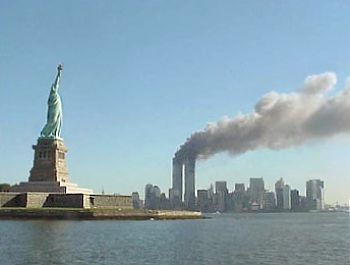One night over cocktails almost two years
ago Dr Cecilia Abecassis-Empis and Jo Rush started talking about what they
respectively do; Cecilia, an academic at the BRE Centre for Fire Safety
Engineering; and Jo, a freelance theatre director. The conversation, like many, quickly moved
onto the causes of the 9/11 structural collapses of the World Trade Centre
(WTC) towers. Cecilia’s and Luke Bisby’s (who over-hearing the conversation
could not help but chime in) frustration that the scientific reasoning and underlying
messages around these events were not being heard sparked an idea in the
creative recesses of Jo’s mind: Towers of Babel was born.
 Jo commissioned a play-wright friend to
start coming up with ideas and plot lines around the research into the WTC
tower collapses, and explore the reasons why the message was not being heard by
engineers and the public alike. Conversations over dinner, skype, and at
conferences kept the juices flowing and the more questions were answered about “whose
fault was it?”, “why has nothing changed?”, and “what other risks are
out there?”, the more the play took its initial form.
Jo commissioned a play-wright friend to
start coming up with ideas and plot lines around the research into the WTC
tower collapses, and explore the reasons why the message was not being heard by
engineers and the public alike. Conversations over dinner, skype, and at
conferences kept the juices flowing and the more questions were answered about “whose
fault was it?”, “why has nothing changed?”, and “what other risks are
out there?”, the more the play took its initial form.
However
we needed to know whether the characters rang true and whether the message that
we wanted to say was coming across. We gave to the play to the actors. At a read-through
at the University of Edinburgh in July 2014 five actors along with the
play-wright, Jo, and a few academics examined every nuance of story and
character. It was a success, and with some final polishing off a final script would be ready.
 This
is where we are now, with the play-wright looking at the changes and editing
the script, and the director looking to expose the play to the public audience. We are hoping to be previewing the work
sometime early next year – with plans to take it to a full production soon
afterwards. Watch
this space.
This
is where we are now, with the play-wright looking at the changes and editing
the script, and the director looking to expose the play to the public audience. We are hoping to be previewing the work
sometime early next year – with plans to take it to a full production soon
afterwards. Watch
this space.
Synopsis:
“Towers
of Babel is an exciting new play that explores culpability, collusion, and
the risks we take every day. It draws on specific research by the University of
Edinburgh into why and how the World Trade Centre towers fell on 9/11, and asks
why the engineering community, in general, is not acting upon the significant
gaps in our understanding of fire exposed by this terrible event. Using this
specific engineering failure as its focus, the play engages with wider
questions about the blame culture in our society, the engineering choices made
between financial cost and human cost, and how engineers quantify, manage and
articulate risk to the wider public.”
For
more details about any aspect of the show please contact David Rush:
d.rush@ed.ac.uk







